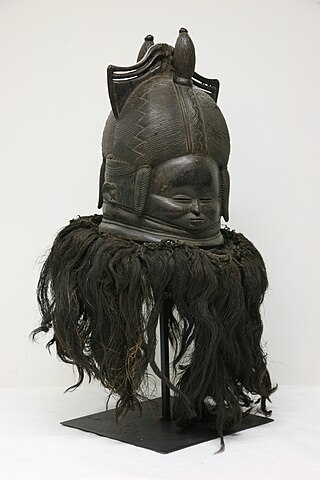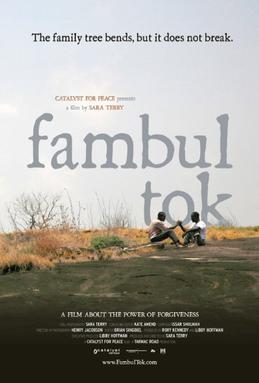Related Research Articles

Sierra Leone, officially the Republic of Sierra Leone, is a country on the southwest coast of West Africa. It shares its southeastern border with Liberia and is bordered by Guinea to the north. With a land area of 71,740 km2 (27,699 sq mi), Sierra Leone has a tropical climate and with a variety of environments ranging from savannas to rainforests. According to the 2015 census, Sierra Leone has a population of 7,092,113, with Freetown serving as both the capital and largest city. The country is divided into five administrative regions, which are further subdivided into 16 districts.

Alhaji Ahmad Tejan Kabbah was a Sierra Leonean politician who served twice as the 3rd President of Sierra Leone, from 1996 to 1997 and again from 1998 to 2007. An economist and attorney by profession, Kabbah spent many years working for the United Nations Development Programme. He retired from the United Nations and returned to Sierra Leone in 1992.
Anaang is an ethnic group in Southern Nigeria, whose land is primarily within 8 of the present 31 Local Government Areas in Akwa Ibom State: Abak, Essien Udim, Etim Ekpo, Ika, Ikot Ekpene, Obot Akara, Oruk Anam, Ukanafun in Akwa Ibom State. The Anaang are the second largest ethnic group after the Ibibios in Akwa Ibom state.

The Mende are one of the two largest ethnic groups in Sierra Leone; their neighbours, the Temne people, constitute the largest ethnic group at 35.5% of the total population, which is slightly larger than the Mende at 31.2%. The Mende are predominantly found in the Southern Province and the Eastern Province. The Mende are mostly farmers and hunters. Some of the major cities with significant Mende populations include Bo, Kenema, Kailahun, and Moyamba.

The Gullah are a subgroup of the African American ethnic group, who predominantly live in the Lowcountry region of the U.S. states of South Carolina, North Carolina, Georgia, and Florida within the coastal plain and the Sea Islands. Their language and culture have preserved a significant influence of Africanisms as a result of their historical geographic isolation and the community's relation to their shared history and identity.

Bo, also commonly referred to as Bo Town, is the third largest city in Sierra Leone by population and the largest city in the Southern Province. Bo is the capital and administrative centre of Bo District. The city of Bo has a population of 223,075 based on 2021 national mid-term census estimates. Bo is an urban centre, and lies approximately 160 miles (250 km) east-southeast of Freetown, and about 40 miles (64 km) to Kenema. Bo is the leading financial, educational and economic centre of southern Sierra Leone.

Colón is a municipality and city in the Matanzas Province of Cuba. The municipality has an area of 547 km2 (211 sq mi) and a population of about 68,021. The city proper, with a population of about 44,000, is the third-largest of its province.
Jamaican Maroons descend from Africans who freed themselves from slavery on the Colony of Jamaica and established communities of free black people in the island's mountainous interior, primarily in the eastern parishes. Africans who were enslaved during Spanish rule over Jamaica (1493–1655) may have been the first to develop such refugee communities.

Joseph A. Opala, OR is an American historian noted for establishing the "Gullah Connection," the historical links between the indigenous people of the West African nation of Sierra Leone and the Gullah people of the Low Country region of South Carolina and Georgia in the United States.
Kalangba (/kælæŋbæ/)(Loko: Ngangba) is a rural village in Bombali District, Northern Province, Sierra Leone. It is the headquarters for Ngowahun Chiefdom. It is situated about 15 miles (24 km) northwest of Makeni, the largest city in Sierra Leone's northern region. Kalangba is approximately 134 miles (216 km) north-east of the nation's capital, Freetown. It is a multicultural community. The majority of the inhabitants belong to the Loko ethnic group as well as the Fula and Mandingo. The Loko are the fifth largest ethnic group in Sierra Leone. As of the 2016 census, the population was 3,000.
Mandingo people of Sierra Leone is a major ethnic group in Sierra Leone and a branch of the Mandinka people of West Africa. Most Sierra Leonean Mandingo are the direct descendants of Mandinka settlers from Guinea, who settled in the north and eastern part of Sierra Leone, beginning in the late 1870s to the 1890s under the rule of prominent Mandinka Muslim cleric Samori Ture. Also later a significantly large population of Mandinka from Guinea migrated and settled in Eastern Sierra Leone and Northern Sierra Leone in the early to mid 20th century. The Mandingo people of Sierra Leone have a very close friendly and allied relationship with their neighbors the Mandingo people of Guinea and Liberia, as they share pretty much identical dialect of the Mandingo language, tradition, culture and food.
William Gwinn was an African American from Boston, Massachusetts. He was one of the first black Americans to participate in the antebellum American Back-to-Africa movement under the auspices of Captain Paul Cuffe's 1815 voyage to Sierra Leone.

Elizabeth II was Queen of Sierra Leone from 1961 to 1971, when Sierra Leone was an independent constitutional monarchy. She was also the monarch of other Commonwealth realms, including the United Kingdom. Her constitutional roles in Sierra Leone were mostly delegated to the governor-general of Sierra Leone.

Art in Sierra Leone has a long and significant tradition of carving and ceremonial works like masks and cloth for initiation and protection. Although art styles are oftentimes ascribed to a single ethnic group, the styles and processes are spread throughout the country and many artists move between the different ethnic groups in the country.

Fambul Tok is a 2011 American documentary film about an organization that aims at reconciliation and forgiveness in communities that were affected by a long-running civil war in Sierra Leone. The film was directed by journalist Sara Terry and it premiered at the South by Southwest film festival. The title of the film is the organization's name, which translates to "family talk" in the Krio language. The film has received mixed reviews from critics. An epilogue to the film documented the community's reconciliation process with one of the major perpetrators of violence during the war.

An Ebola virus epidemic in Sierra Leone occurred in 2014, along with the neighbouring countries of Guinea and Liberia. At the time it was discovered, it was thought that Ebola virus was not endemic to Sierra Leone or to the West African region and that the epidemic represented the first time the virus was discovered there. However, US researchers pointed to lab samples used for Lassa fever testing to suggest that Ebola had been in Sierra Leone as early as 2006.

Sierra Leone is home to about sixteen ethnic groups, each with its own language. In Sierra Leone, membership of an ethnic group often overlaps with a shared religious identity. According to the 2004 census Temne is the largest ethnic group in Sierra Leone.

The Saro, or Nigerian Creoles of the 19th and early 20th centuries, were Africans that were emancipated and initially resettled in Freetown, Sierra Leone by the Royal Navy, which, with the West Africa Squadron, enforced the abolition of the international slave trade after the British Parliament passed the Slave Trade Act 1807. Those freedmen who migrated back to Nigeria from Sierra Leone, over several generations starting from the 1830s, became known locally as Saro(elided form of Sierra Leone, from the Yoruba sàró). Consequently, the Saro are culturally descended from Sierra Leone Creoles, with ancestral roots to the Yoruba people of Nigeria.

The title First Lady of Sierra Leone is held by the female spouse of the president of Sierra Leone. The first lady is a representative of the people of Sierra Leone at home and abroad. The Office of the First Lady is an extension of State House and is responsible for social events and ceremonies at State Lodge. The First Lady’s Office is not established by an act of parliament and cannot receive government funding.

Sierra Leonean nationality law is regulated by the Constitution of Sierra Leone, as amended; the Citizenship Act, and its revisions; and various international agreements to which the country is a signatory. These laws determine who is, or is eligible to be, a national of Sierra Leone. The legal means to acquire nationality, formal legal membership in a nation, differ from the domestic relationship of rights and obligations between a national and the nation, known as citizenship. Nationality describes the relationship of an individual to the state under international law, whereas citizenship is the domestic relationship of an individual within the nation. In Britain and thus the Commonwealth of Nations, though the terms are often used synonymously outside of law, they are governed by different statutes and regulated by different authorities. Sierra Leonean nationality is based on descent from a person who is Negro-African, regardless of whether they were born in Sierra Leone, jus soli, or abroad to a Sierra Leonean, jus sanguinis. The Negro clause was inserted based upon the founding of the colony as a refuge for former slaves to prevent economically powerful communities from obtaining political power. It can be granted to persons with an affiliation to the country, or to a permanent resident who has lived in the country for a given period of time through naturalisation.
References
- ↑ "How Cuban Villagers Learned They Descended from Sierra Leone Slaves". The Atlantic . 22 April 2013.
- ↑ "Cubans trace roots to remote Sierra Leone village". BBC News. 21 April 2014.